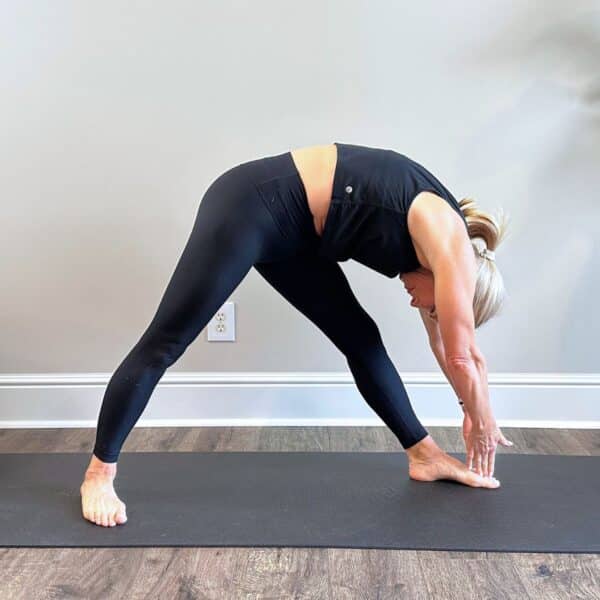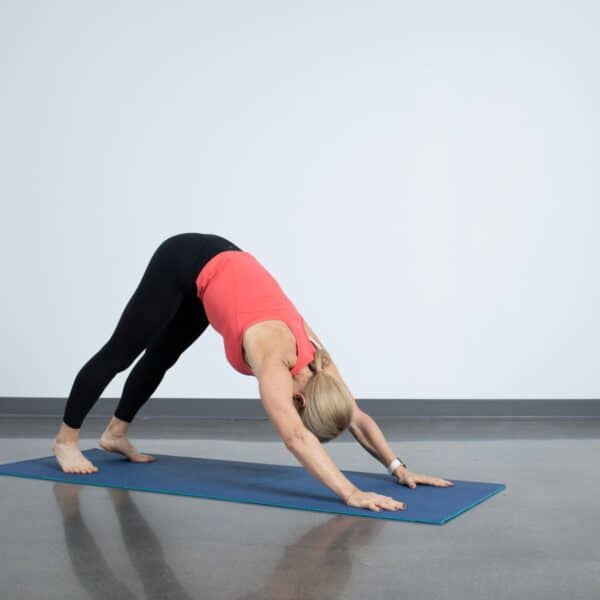This post contains affiliate links. Please see our disclosure policy.
Your target heart rate zone—the range of heartbeats per minute you should aim for while exercising—can boost cardiovascular health, increase calorie burning, and make your workouts more effective and efficient.
Everyone loves a good heart-pumping workout—but are you pushing yourself too hard? Or maybe not hard enough? Monitoring your heart rate during exercise is essential for optimizing your workout intensity and efficiency.
You don’t want to overdo it, but you also don’t want to let yourself off too easy—and that’s where your target heart rate zone comes into play.
I’m going to explain benefits of exercising within your target heart rate zone, how it’s calculated, and tips for optimizing each training zone.
What Is a Target Heart Rate Zone?
Your target heart rate zone is the range of heartbeats per minute that you should aim for during exercise. It’s based on factors such as age, fitness level, and specific medical conditions, and helps ensure you’re exercising at the optimal level for your specific fitness goals.
Knowing your optimal heart rate range can help you work smarter, not longer—saving precious time and making your workouts way more effective.
Working out within your target heart rate zone can also:
- Optimize cardiovascular health: Exercising in your target heart rate zone helps strengthen your cardiovascular system (including your heart and lungs), improves blood circulation, and increases the efficiency of oxygen delivery to your muscles. This improves endurance and reduces the risk of cardiovascular diseases such as heart attacks, strokes, and high blood pressure.
- Burn more calories: At the right training intensity, your body utilizes a greater amount of energy, which results in more calories burned (ideal for weight loss).
- Boost your overall fitness: Regularly exercising within your target heart rate zone can increase your aerobic capacity, muscle strength, and endurance. This helps your body recover from intense workouts, which reduces the risk of fatigue and injuries.
What are the Heart Rate Training Zones?
First, it’s important to look at the different heart rate zones that correspond to different workout intensities. Keep in mind that these zones are based on a maximum heart rate of 100 percent—in other words, maxing out your heart!
Before explaining each zone in more detail, here’s a quick breakdown:
| Zone 1 (Light) | A walk with friends. |
| Zone 2 (Easy) | A power walk or easy jog; you are able to carry on a conversation. |
| Zone 3 (Moderate) | A run; you can speak in phrases, but it’s not conversational. |
| Zone 4 (Hard) | You are unable to speak; you’re breathing and panting through your mouth. |
| Zone 5 (All Out) | A sprint; complete overload after 30 seconds or so. |
Now that you have a general idea, let’s look at each zone in more detail:
Zone 1: Recovery
This is characterized by a heart rate that is 50-60% of your maximum heart rate, ideal for warm-up exercises and active recovery. Think of this zone as a walk with friends—you’re moving, but your breathing is moderate, and you can carry on a conversation and even laugh. It’s something you could do for a long time.
Zone 2: Fat Burning
The fat-burning zone corresponds to a heart rate of 60-70% of your maximum heart rate, which is where your body starts to burn fat for fuel. This zone would be like going for a jog—you are still able to breathe through your nose, but you need to use your mouth a bit more than you would during Zone 1.
Zone 3: Aerobic
This zone falls within the range of 70-80% of your maximum heart rate, where your body gains the most cardiovascular benefits and improves endurance. Think of running rather than jogging—it’s more intentional and purposeful. You breathe solely through your mouth. Think of “serious work” for this zone.
Zone 4: Anaerobic
The anaerobic zone is characterized by a heart rate of 80-90% of your maximum heart rate. This is the first crossover from aerobic (with oxygen) to anaerobic (without oxygen). Simply put, you run out of breath! Think of this as a “go hard” zone, such as performing intervals (as you would with a HIIT workout) where you go hard for a short time, then take a quick recovery before starting again.
Zone 5: Red Line Zone
Here, you’re reaching a heart rate of 90-100% of your maximum heart rate. It is the highest intensity zone and should be approached with caution. Typically speaking, this zone is reserved for serious, endurance athletes because you work to your maximum heart rate. The training times are super short—seconds—and very intense. Zone 5 will make you feel like every muscle in your body is burning.
The best way to train within your target heart rate zone is to monitor your heart rate during exercise by checking your pulse or using a heart rate monitor. Choose workouts that elevate your heart rate to the desired zone, and then adjust the intensity as needed to stay within your target range.
How to Calculate Your Target Heart Rate Zone
To calculate your target heart rate zone, you need to determine your maximum heart rate and the desired percentage of that maximum you want to reach while working out. (For example, if you want to reach 70 to 80 percent of your max heart rate, you’ll choose exercises in Zone 3.)
The most commonly used formula is the Karvonen method, which takes into account your resting heart rate and provides a more personalized range.
To calculate on your own, here are the detailed steps (Karvonen formula):
- Figure out your resting heart rate (RHR): Take your pulse in the morning after waking up, before any physical activity.
- Calculate your maximum heart rate (MHR): Subtract your age from 220.
- Find your heart rate reserve (HRR): Subtract your resting heart rate from your maximum heart rate. The formula is: (220 – Your Age) – Resting Heart Rate = Heart Rate Reserve
- Determine the lower end of your target heart rate zone: (Heart Rate Reserve × 0.50) + Resting Heart Rate = Lower Limit
- Determine the upper end of your target heart rate zone: (Heart Rate Reserve × 0.85) + Resting Heart Rate = Upper Limit
Example:
Here is an example of a person 30 years old with a resting heart rate of 60 beats per minute (BPM):
| Maximum heart rate | 220 – 30 = 190 BPM |
| Heart rate reserve | 190 – 60 = 130 BPM |
| Lower limit | (130 × 0.50) + 60 = 125 BPM |
| Upper limit | (130 × 0.85) + 60 = 171.5 BPM |
What Heart Rate Zone Should I Train In?
Now that you know your zones and how to calculate your max heart rate, the question remains: Which zone should you train in for best results?
The general rule of thumb is to reach Zone 1 every day if you can! Shoot for a few Zone 3 workouts per week, and try interval training in short bursts in Zone 4 twice a week. Let’s take a look at how this breaks down:
Beginners: Zones 1 and 2
Zone 1: This is essentially your basic movement zone. Since we know that “sitting is the new smoking,” it is important to get just a little movement in every day. Try using a walking pad during your workday, practicing light yoga, sneaking in your gardening or tackling a good deep clean on your house.
Zone 2: This zone is particularly beneficial if you have been inactive for some time or are a beginner to exercise. Try to get into Zone 2 at least three to four times a week while you are getting in shape. Newbies should spend several weeks focusing on Zones 1 and 2 before moving on. Once conditioned, Zone 2 can be a recovery day following an interval workout.
Intermediates: Zones 2 and 3
Once you are physically conditioned, most of your training should be done here. The idea in Zone 3 is to work as hard as you can sustain for 30 to 60 minutes. Try to get a 30-minute workout in Zone 3 at least three times a week.
Remember, you want to be working hard enough to break a good sweat and breathe heavy through your mouth. Don’t forget to incorporate Zone 1 and 2 activities as part of your recovery days rather than just sitting around in between good workouts. Remember, moving is the key!
Advanced or Looking For More: Zones 4 and 5
Zone 4: Want to lose weight more quickly? Interval training is your key. Interval training using Zone 4 only needs to be done twice a week to get amazing results! Research shows that shorter, high-intensity workouts can do more for your health than longer, more leisurely workouts.
Make sure you have spent time in zones 2 and 3 before moving into interval training. The bonus is that due to the high intensity nature of the zone 4 exercise training, you will only need 20 minutes to achieve results. High Intensity Interval Training (HIIT) is a great way to achieve this. Check out our complete guide to HIIT for beginners.
Zone 5: As stated earlier, you are unlikely to train in Zone 5 unless you are a highly trained athlete or a very fit exercise enthusiast (e.g., you’re training for a triathlon).
One last thought: Remember that as you become more fit, your resting heart rate will be lower, and your heart rate zone will change. You always want to improve and challenge your heart!
Once you spend enough time in a certain zone and it becomes more comfortable for you, it’s time to push a little harder and get that heart pumping a bit more. Challenge = Change.
Before Getting Started…
If you have not been exercising regularly and want to start training using these zones, answer these questions first:
- Are you a man over 40 or a woman over 50?
- Have you ever been told you have heart problems or high blood pressure?
- Do you often feel dizzy or light-headed, or notice chest pains?
- Have you had any other health problems or surgeries that you think might complicate your workouts or put you at risk?
If you answered “yes” to any of the above, it’s important to check with your healthcare provider before starting a workout program and training your heart.
To further your research and get more precise data, you can also check out our top picks for heart rate monitors—they can help you be more precise as you’re exercising so you can determine what zones you’re in during a workout.






